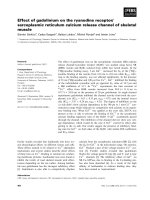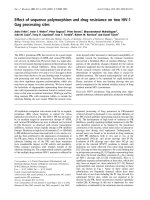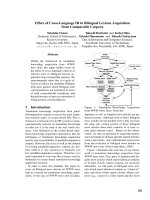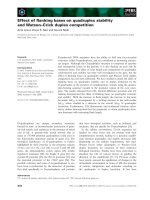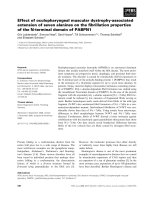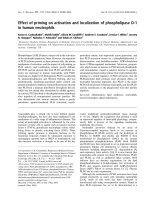Báo cáo khoa học: "Effect of vegetative propagation on field performance up to age 8 of hybrid larch (Larix x eurolepis) clones" pot
Bạn đang xem bản rút gọn của tài liệu. Xem và tải ngay bản đầy đủ của tài liệu tại đây (659.59 KB, 14 trang )
Original
article
Effect
of
vegetative
propagation
on
field
performance
up
to
age
8
of
hybrid
larch
(Larix x
eurolepis)
clones
LE Pâques,
D
Cornu
INRA,
Station
d’amélioration
des
arbres
forestiers,
centre
de
recherche
d’Orléans,
F-45160
Ardon,
France
(Received
15
November
1990;
accepted
15
March
1991)
Summary —
More
than
100
clones
of
hybrid
larch
(Larix
x
eurolepis)
have
been
vegetatively
propa-
gated
by
stem
cuttings
and
their
behaviour
under
field
conditions
been
examined
in
2
clonal
tests
up
to
age
8
and
10
yr.
Rooting
rate
was
high
(87%)
but
very
variable
from
clone
to
clone.
Transfer
of
rooted
cuttings
from
greenhouse
to
the
nursery
remained
a
serious
problem.
No
correlation
between
ortet
vigour
(total
height
at
age
2
yr)
and
rooting
ability
could
be
found.
Rooted
cuttings
behaved
mostly
like
seedlings
for
both
growth
traits
and
stem
form,
at
least
when
taken
from
young
ortets
(2
yr
old).
Age
(2
compared
to
16
yr)
of
donor
plants
seemed
to
have
long-lasting
effects
(up
to
age
10
yr)
on
further
growth
of
ramets.
The
genetic
composition
evolution
of
a
fictive
multiclonal
variety
was
simulated
up
to
age
8
yr.
No
major
change
in
the
representation
of
the
component
clones
could
be
observed.
Larix
x
eurolepis
/ vegetative
propagation
/
stem
cutting
/
clonal
test
/
hybrid
larch
Résumé —
Comportement
en
forêt
à
8
ans
de
clones
de
mélèze
hybride
(Larix
x
eurolepis)
multipliés
par
voie
végétative.
Une
centaine
de
clones
(expérience 1)
et 21
autres
clones
(expé-
rience 2)
de
mélèze
hybride
ont
été
multipliés
végétativement
par
bouturage
horticole
et
installés
à
Eclache
(Puy-de-Dôme)
et
à
Peyrat-Le-Château
(Haute-Vienne).
Le
comportement
des
clones
en
forêt
à
8
ans
(et
10
ans
pour
l’expérience
2)
a
été
étudié
de
manière à
vérifier
l’intérêt
de
la
voie
clo-
nale,
et
en
particulier
le
bien-fondé
de
certaines
critiques
formulées
à
l’encontre
de
la
multiplication
végétative.
Il
ressort
de
cette
étude
que :
-
le
taux
d’enracinement
global
est
élevé
(87%)
mais
varie
notablement
de
clone
à
clone
(37-
100%).
L’acclimatation
des
boutures
enracinées
en pépinière
reste
une
opération
délicate
qui se
tra-
duit par
des
pertes
en
matériel
importantes
(±
50%)
liées
à
un
système
racinaire
insuffisant
et
à
des
conditions
de
repiquage
sur
le
terrain
trop
sévères;
-
il
ne
semble
pas
y
avoir
de
liaison
entre
la
vigueur
de
l’ortet
(sa
taille)
et
son
aptitude
à
l’enracine-
ment;
-
le
niveau
de
croissance
des
plants
bouturés
installés
en
forêt
est
très
semblable
à
celui
observé
pour
les
plants
issus
de
semis
et
la
qualité
de
la
forme
des
tiges
est
comparable,
du
moins
lorsque
le
bouturage
se
fait
à
partir
de
pieds
mères
jeunes
(2
ans);
-
l’âge
des
pieds
mères
semble
avoir
un
effet
durable
sur
la
croissance
ultérieure
des
ramets
qui
en
sont
issus.
À
10
ans,
les
ramets
issus
de
pieds
mères jeunes
(2
ans
depuis
la
graine)
conservent
un
avantage
pour la
croissance
très
net
par
rapport
aux
ramets tirés
de
pieds
mères
âgés
(16 ans);
-
parmi
les
soucis
majeurs
posés
par
la
multiplication
en
masse
d’une
variété
clonale,
une
dérive -
immédiate
(lors
du
bouturage)
mais
aussi
progressive
(au
cours
de
la
vie
du
peuplement)—de
sa
composition
génétique
limiterait
la
diversité
génétique
initiale
recherchée
avec
les
risques
que
cela
comporte.
Une
simulation
de
l’évolution
au
cours
du
temps
(jusqu’à
8
ans)
de
la
représentativité
de
chaque
clone
dans
la
variété
clonale
montre
que
dans
le
cadre
de
cette
étude,
les
risques
de
dérive
sont
mineurs
et
acceptables.
L’étude
de
l’intérêt
économique
de
la
voie
végétative
par
rapport
à la
voie
sexuée
n’a
pas
été
abordée
dans
cet
article.
Le
niveau
des
gains
génétiques
attendus
sera
étudié
par
ailleurs.
Larix
x eurolepis
/
multiplication
végétative
/
bouturage
/
test
clonal / mélèze
hybride
INTRODUCTION
The
hybrid
between
the
European
(Larix
decidua
Mill)
and
Japanese
larches
(Larix
kaempferi
(Sarg)
Carr)
has
proved
to
be
a
valuable
reforestation
material
in
many
ex-
periments
(Bastien
and
Keller,
1980;
Gothe,
1987).
Its
superiority
over
one
or
both
of
its
parental
species
has
been
illus-
trated
for
many
important
traits
such
as
vigour,
form
and
canker
resistance
(Pâques, 1989).
Once
a
hybrid
formula
(usually
a
full-sib
family)
is
selected
for
its
outstanding
per-
formances,
questions
about
its
mass
prop-
agation
arise.
In
order
to
take
advantage
of
both
additive
and
dominance
genetic
ef-
fects,
2
propagation
systems
are
available
to
tree
breeders,
namely
bi-clonal
hybridi-
zation
seed
orchards
and
vegetative
prop-
agation
by
cuttings.
Propagation
through
sexual
reproduc-
tion
in
hybridization
orchards
appears
in
many
ways
problematic
for
biological
con-
straints
such
as
non-overlapping
phenolo-
gy
between
the
clones
of
the
different
spe-
cies,
for
genetic
limits
(eg
purity
level
of
hybrid
seed,
narrow
genetic
base
of
biclo-
nal
orchard
progeny),
for
economic
rea-
sons
(cost
of
investment
and
delay
in
re-
turns)
and
connected
with
this,
reduced
flexibility
for
mass-propagation
of
new
va-
rieties.
Vegetative
propagation
is
in
this
respect
much
more
flexible
and
suited
to
a
rapid
diffusion
of
new
improved
varieties.
Stem
cutting
techniques
are
available
for
larches
(Mason,
1984;
Morgenstern,
1987;
Jacques
and
Nanson,
1989)
among
which
propagation
of
selected
individuals
(ortets)
managed
in
hedged
clone
archives
and,
al-
ternatively,
"bulk"
propagation
of
young
forced
seedlings
of
entire
selected
families
are
of
interest.
Validity
of
both
techniques
is
guaran-
teed
by
a
high
rate
of
multiplication
per
do-
nor
plant
(ie
number
of
cuttings
which
can
be
taken
per
tree
x
level
of
rooting
suc-
cess),
by
a
stable
and
balanced
represen-
tation
of
each
clone
in
the
clonal
variety,
a
physiological
quality
of
clonal
material
at
least
equivalent
to
similar
genetic
seedling
material,
and
the
genetic
quality
of
the
propagated
clones.
Propagation
of
multiclonal
varieties
from
selected
donor
plants
(ortets)
faces
2
addi-
tional
major
problems:
efficiency
of
selec-
tion
and
management
of
ageing
in
the
do-
nor
plant
collections.
The
objective
of
this
paper
was
to
deter-
mine
the
feasibility
and
the
value
of
stem
cutting
propagation
in
selected
hybrid
larch
clones.
The
following
points
have
been
ex-
amined:
i),
clonal
variation
of
rooting
abili-
ty;
ii),
influence
of
ortet
vigour
on
rooting
ability;
iii),
evolution
of
the
genetic
compo-
sition
of
a
fictive
multiclonal
variety;
and
iv),
forest
behaviour
of
cloned
material,
in
particular
with
respect
to
the
age
effect
of
donor
plants
and
in
comparison
to
seed-
lings.
A
second
paper
will
study
basic
genetic
parameters
of
vegetatively
propagated
ma-
terial
in
order
to
determine
the
level
of
ge-
netic
gains
to
be
expected
through
clonal
selection.
MATERIALS
AND
METHODS
Observations
and
results
derived
from
2
different
experiments
Experiment
1
101
clones
of
Larix
x
eurolepis
(European
x
Jap-
anese
larches)
(coded
Ldk
C)
were
selected
in
a
progeny
test
at
age
2
yr
among
14
full-sib
fami-
lies
created
in
1979
at
the
INRA
Research
Sta-
tion,
Orléans.
Ortets
were
potted
in
autumn
1981
and
forced
under
greenhouse
conditions
a
couple
of
weeks
before
propagation.
Softwood
cuttings
(=
10
cm
long)
were
taken
in
May
1982,
dipped
in
talc
powder
including
0.5%
IBA
and
a
fungicide,
and
rooted
in
a
medi-
um
mixture
(2:
1:
3)
of
peat,
compost
and
pouz-
zolane
under
greenhouse
conditions.
An
inter-
mittent
mist
was
used
and
alternating
fungicide
treatments
were
applied
as
necessary.
Rooted
cuttings
were
transferred
to
INRA
nursery
in
March
1983,
2
yr
before
being
field-planted.
Rooted
material
was
planted
on
one
test
site
in
the
Eclache
state
forest
in
December
1984.
The
site
is
located
in
the
Massif
Central
(Puy-
de-Dôme,
long
2°41’E,
lat
45°44’N,
elev
1
000
m)
and
can
be
regarded
as
a
good
conifer
forest
site
(deep
forest
brown
soil,
high
level
of
annual
rainfall
(up
to
1
000
mm)),
except
for
the
windy
conditions.
An
incomplete
balanced
random
blocks
de-
sign
was
used
with
9
blocks,
95
plants
per
block
and
2
non-contiguous
tree
plots
per
clone
and
per
block.
Spacing
was
3
x
3
m
wide.
Seedlings
of
2
full-sib
families of
Larix
x
Eu-
rolepis
(coded
Ldk
S)
were
included,
one
of
them
being
represented
both
by
seedlings
(F0001
S)
and
by
10
clones
(F0001
C).
Other
seedlings
(coded
Lkd
S)
and
25
clones
(coded
Lkd
C)
selected
at
age
3
yr
from
a
Danish
seed
orchard
(FP203
=
F0025)
progeny
were
added
as
well.
This
orchard
produces
the
reciprocal
hy-
brid
Larix
x
leptoeuropaea
(Japanese
x
Europe-
an
larches).
Sowing
took
place
in
the
same
nur-
sery
but
1
yr
later
than
vegetative
propagation.
Experiment
1
was
the
first
large-scale
experi-
ment
conducted
at
the
INRA
Research
Station
on
vegetative
propagation
of
hybrid
larch.
Experiment
2
Experiment
2
consisted
of
a
small
clonal
test
in-
cluding
21
clones
of
Larix
x
eurolepis
selected
from
the
progeny
of
another
Danish
hybridiza-
tion
seed
orchard
(FP201 ).The
age
effect
of
do-
nor
stock
on
further
development
of
cuttings
was
studied.
Seven
clones
were
chosen
for
stem
straightness
in
a
provenance
test
(Coat-
An-Noz,
Brittany)
in
1973
at
age
16
yr
(from
seed)
and
grafted
on
potted
rootstocks
at
the
INRA
Orléans
nursery
(old
material).
Fourteen
other
clones
were
selected
for
the
same
criteria
among
2-yr-old
seedlings
by
year
of
vegetative
propagation
(young
material).
In
spring
1978,
the
21
clones
were
vegeta-
tively
propagated
by
stem
cuttings
and
planted
at
one
site
in
Peyrat-Le-Château
(Haute-Vienne,
long
1 °44’E;
lat
45°49’N;
elev
450
m;
western
range
of
the
Massif
Central)
in
spring
1981.
The
experimental
design
was
a
complete
random
block
design
with
8
blocks
and
single
tree
plots.
Spacing
was
3
x
2
m.
Measurements
and
observations
Besides
total
height
of
ortets
measured
in
1981
at
age
2
yr
(from
seed,
coded
H81/2),
nursery
measurements
included:
the
rate
of
rooting
suc-
cess
(%RC82),
the
quality
of
the
root
system
as-
sessed
by
a
notation
scale
with
4
scores
(1
=
numerous
roots
well
distributed
around
the
stem
base;
2
=
intermediate;
3
=
poor
root
system
with
1
or
2
roots
and
a
unilateral
distribution;
4
=
no
root)
and
the
percentage
of
plantable
cuttings
prior
to
planting
(%PC84).
The
latter
was
based
on
the
proportion
of
viable
cuttings
with
a
good
root
system
quality
(score
1
or
2).
Forest
observations
were
made
in
1989
for
experiment
1
(8
yr
after
propagation)
and
in
1987
(10
yr
after
propagation)
for
experiment
2.
They
concerned
survival
rate
(%S),
total
height
(H),
the
length
of
the
cumulated
shoot
growth
in-
crements
from
plantation
(CI),
girth
at
breast
height
(BHG)
(only
in
experiment
2),
frequency
of
basal
sweep
(%BS),
stem
straightness
(SS) -
a
notation
with
5
scores
was
used
(1
=
very
poor,
5
=
straight
stem) -
and
frequency
of
crooked
stems
(scores
<
4
in
the
previous
scale)
(%CS).
Branch
angle
and
forking
were
observed
in
experiment
2
but
as
no
variation
was
observed,
they
were
discarded
before
anal-
ysis.
Analysis
of
data
Experiment
1
Statistical
methods
used
were
Spearman
rank
correlations
between
ortet
performances
and
rooting
traits
of
clones
and
comparison
of
means
by
Student-Fisher
t-test
for
comparison
of
seedling-cutting
performances
(Dagnelie,
1975).
Homogeneity
of
frequency
data
was
test-
ed
using
test
I
(Arbonnier,
1966)
with:
with
X
ij
=
number
of
observations
of
type
i
and
score
j; X
i,
Xj
=
marginal
sum
of
observations;
n
=
number
of
scores;
k
= number
of
types;
N
=
total
number
of
observations.
It
follows
a
χ
2
distribution
with
(k-1)
(n-1)
de-
grees
of
freedom.
Experiment
2
Age
of
donor
plants
and
clone
(within-age)
ef-
fects
were
tested
following
an
analysis
of
vari-
ance
on
individual
data
according
to
the
model:
with
=
= general
mean;
Bi
= effect
of
block
i;
Aj
=
effect
of
donor
plant
age
j;
C/A
k(j)
=
effect
of
clone
k
of
donor
plant
of
age
j;
ϵ
ijkl
=
residual
er-
ror.
Main
factors
were
considered
as
random.
Test
I
(Arbonnier,
1966)
was
used
to
test
homo-
geneity
of
response
for
frequency
data.
RESULTS
AND
DISCUSSION
Rooting
ability
and
quality
(exp 1)
Average
values
of
rooting
characteristics
are
given
in
table
I for
hybrids
Ldk
C
and
Lkd C.
Rooting
rate
was
particularly
high
for
Ldk
C
as
well
as
its
general
root
system
quality:
out
of
2748
cuttings,
87%
were
rooted
and
88%
of
rooted
cuttings
had
a
good
root
system.
Hybrid
Lkd
C,
on
the
other
hand,
was
much
less
successful
if
one
considers
the
rate
of
rooting
(64%),
the
number
of
remaining
clones
before
plantation
and
especially
the
rate
of
planta-
ble
cuttings:
14.1 %.
This
parameter,
which
takes
into
account
rooting
success
per-
centage,
root
system
quality
and
survival
in
the
nursery
until
forest
plantation
was
not
very
high
for
Ldk
C
either,
as
just
1
cutting
out
of
2
taken
in
1982
from
donor
plants
could
be
finally
planted
in
1984.
The
poor
results
noted
for
hybrid
Lkd
C
clones
might
be
explained
by
the
fact
that
Lkd
donor
plants
are
1
yr
older
than
Ldk
plants.
Mason
(1984)
recommended
that
stock
plants >
2
yr
from
seed
should
not
be
used.
Rooting
rates
observed
in
this
study
for
Larix
x
eurolepis
were
somewhat
weaker
than
comparable
results
reported
in
the
lit-
erature.
For
cuttings
collected
and
inserted
in
early
May,
Mason
(1989)
obtained
over-
all
rooting
percentages
as
high
as
95%.
Numerous
factors
might
explain
this
differ-
ence
in
success:
history
of
stock
plants,
developmental
stage
of
the
twigs
at
time
of
collection,
rooting
environment
and
clone
variability
in
rootability.
Indeed,
a
high
variability
of
the
rooting
response
existed
both
between
families
and
between
clones;
the
rooting
rates
am-
plitude
had
a
range
of
76.0-94.0%
be-
tween
families
and
37-100%
between
for
Ldk
C,
while
percentages
of
plantable
cuttings
varied
from
20.8-64.4%
between
families
and
from
0-97%
be-
tween
clones.
Test
I was
significant
for
the
3
characteristics
(rooting
rate,
root
system
quality
and
rate
of
plantable
cuttings)
re-
vealing
non-homogeneity
of
the
rooting
re-
sponse
of
clones
at
the
family
level.
Varia-
tion
between
ramets
also
existed
and
may
be
important
for
part
of
the
clone
1
for
traits
such
as
root
system
quality.
Nevertheless,
as
shown
in
fig
1 a,
b,
c,
the
frequency
of
clones
with
a
rooting
rate
of
at
least
70%
and
an
equivalent
propor-
tion
of
good
rooted
cuttings
(types
1
and
2)
was
high
as
it
reached
more
or
less
80%
but
before
plantation,
nearly
50%
of
the
clones
had
<
50%
of
plantable
ramets,
indicating
serious
problems
connected
with
transfer
from
greenhouse
to
nursery.
Influence
of
ortet
vigour
on
rooting
ability
(experiment 1)
Rank
correlations
between
rooting
charac-
teristics
and
between
these
traits
and
total
height
of
ortets
at
age
2
yr
in
the
nursery
were
computed.
Positive,
highly
significant
(a
=
0.001)
correlations
existed
between
rooting
characteristics
(table
II),
though
these
were
not
very
high.
No
correlation
(significantly
different
from
0
at
α
=
0.05)
could
nevertheless
be
found
between
root-
ing
traits
and
ortet
vigour
(H81/2).
Truncation
of
the
initial
population
through
selection
might
affect
a
generaliza-
tion
of
this
conclusion.
But
even
in
the
fam-
ilies
where
selection
intensity
had
been
the
weakest
(P
=
35%),
vigour
of
ortets
was
not
correlated
with
rooting
response
traits.
Genetic
changes
in
composition
of multiclonal
varieties:
a
study
case
(experiment 1)
Equal
representation
of
clones
in
the
final
composition
of
a
multiclonal
variety
is
a
guarantee
of
protection
of
its
genetic
diver-
sity.
Several
factors
ensure
equal
repre-
sentation
of
clones.
They
concern
donor
plant
reactions
in
terms
of
vigour
and
thus
of
number
of
cuttings
which
can
be
taken
and
the
rapidity
with
which
they
become
mature;
they
also
concern
clone
rooting
ability
and
their
aptitude
to
survive
both
un-
der
nursery
and
forest
plantation
condi-
tions.
Taking
into
account
rooting
parameters
in
experiment
1,
namely
rooting
percent-
age,
quality
of
the
root
system
and
survival
in
nursery
as
well
as
in
the
forest
up
to
age
8
yr,
a
simulation
was
attempted
in
order
to
determine
a
possible
drift
in
the
initial
composition
of
a
fictive
multiclonal
variety.
Twenty
clones
selected
(out
of
100
clones)
on
the
basis
of
an
index
combining
vigour
and
stem
straightness
at
age
8
yr
(Pâques,
unpublished
observations)
were
chosen
with
the
assumption
that
the
same
initial
number
of
cuttings
per
clone
was
taken
so
that
each
clone
had
an
equal
rel-
ative
representation
in
the
fictive
multiclo-
nal
variety
(ie
5%)
prior
to
rooting.
Evolution
of
the
relative
loss
or
gain
of
representation
is
presented
in
figure
2
at
3
stages:
after
rooting
(yr
1),
at
plantation
time
(yr
3)
and
in
the
forest
(yr
8).
It
is
in-
teresting
to
note
that
the
discrepancy
from
the
initial
representation
is
limited
to
a
loss
or
gain
of
-3
to
+3.5%
at
maximum
and
concerns
a
minority
of
clones.
Compensa-
tion
between
rooting
ability,
nursery
trans-
fer
adaptability
and
survival
in
forest
seems
to
exist
and
to
be
able
to
maintain
a
rather
stable
representation
of
clones.
Several
other
simulations
have
been
tested
including
various
numbers
of
select-
ed
clones
(minimum
20)
or
considering
family
level
of
clones.
Similar
results
were
observed
and
are
even
more
encouraging.
As
in
the
present
case,
genetic
diversity
and
its
clonal
equal
relative
representation
are
ensured.
Nevertheless,
this
does
not
mean
that
because
of
between
clones
ageing
vari-
ability
or
for
purely
genetic
reasons
-some
clones
respond
very
poorly
to
vegetative
propagation-
selection
for
rooting
ability
should
not
have
to
be
considered
as
a
spe-
cific
selection
criteria,
at
least
as
far
as
this
trait
is
not
negatively
correlated
with
other
traits
of
interest.
Behaviour
of
clonally
propagated
material
in
the
forest
Age
effect
of
the
donor
plant
(experiment
2)
Comparison
of
performances
at
age
10
yr
(from
propagation)
have
been
presented
in
table
III
for
cuttings
taken
from
young
(2-
yr-old)
and
old
(16-yr-old)
donor
plants
se-
lected
in
the
same
seed
orchard
progeny.
Besides
means
and
coefficients
of
varia-
tion,
tests
results
(namely
F-test
and
I-test)
have
also
been
given.
Vigour
(total
height
and
girth
at
age
10
yr)
was
particularly
high
for
both
materials
and
one
of
the
strongest
recorded
in
France
for
Larix
x
eurolepis.
Nevertheless,
significant
differences
(at
a
=
0.05)
existed
between
performance
material
in
the
2
age
classes.
On
average,
young
material
clones
were
superior
to
old
ones
by
>
11.0%
and
7.7%
respectively
for
H87/10
and
CI81-87,
but
the
most
spectacular
dif-
ference
occurred
in
favour
of
young
materi-
al
for
breast
height
girth
(up
to
36.5%).
This
result
is
somewhat
in
opposition
to
the
findings
of
Morgenstern
(1987),
who
studied the
age
effect
of
parent
plant
on
rooting
for
Larix
laricina.
Age
effect
was
strong
on
rooting
but
though
differences
between
age
classes
(3-4
to
9-10)
persist-
ed
to
the
5th
year
on
height
growth
of
cuttings,
they
became
insignificant.
Among
possible
explanations,
it
is
worth
noting
that
the
latter
study
compared
age
effects
with
clones
of different
genetic
origins
and
that
the
older
age
class
was
=
6 yr
younger
than
in
our
study.
In
both
studies,
’C’
ef-
fects
(defined
by
Burdon
and
Shelbourne
(1974)
as
’maternal’
effect
common
to
all
ramets
of
a
clone)
due
to
different
environ-
ments
of
parent
plants
were
supposed
to
be
negligible.
Clone
within
age
of
donor
plant
effects
were
also
highly
significant
(for
a
=
0.001)
(table
IV).
Except
for
one
clone,
all
the
oth-
er
clones
from
old
material
had
below
av-
erage
performances
but
2
clones
from
young
material
also
performed
very
poorly.
Regarding
stem
form,
no
significant
dif-
ferences
between
age
of
donor
plants
(for
a
=
0.05)
seemed
to
exist
at
that
age
while
clone
within
age
effects
were
highly
signifi-
cant
(a
=
0.001)
for
SS87/10
(table
IV).
Considering
main
source
factors
as
ran-
dom,
variance
components
were
estimated
and
have
been
presented
in
table
IV
as
percentages
of
total
variance.
Except
for
SS87/10,
expected
variance
for
age
of
do-
nor
plants
constituted
a
major
part
of
the
total
variance
and
was
even
superior
to
clone/age
variance
but
for
most
traits,
the
error
term
absorbed
the
largest
part
of
the
total
variance.
Comparison
of
seedlings
and
rooted
cuttings
(experiment
1)
Two-yr-old
seedlings
(S)
and
3-yr-old
root-
ed
cuttings
(C)
from
2
families,
1
full-sib
of
Larix
x
eurolepis:
F0001
and
1
seed
orchard
progeny
of
Larix
x
leptoeuro-
paea:
F0025,
were
compared
under
forest
conditions
in
exp
1
for
survival,
vigour
and
stem
form
traits
up
to
1989.
Unfortunately,
seedlings
from
both
families
were
repre-
sented
by
a
rather
low
number
of
individu-
als.
Mean
performances
and
variability
have
been
presented
in
table
V.
Tests
of
com-
parison
of
means
(or
frequencies)
(tests
t
and I)
showed
that
seedlings
and
cuttings
of
both
families
were
highly
comparable
for
most
traits.
Exceptions
existed,
however,
for
family
F0025;
seedlings
were
signifi-
cantly
(a
=
0.05)
superior
to
cuttings
for
H89/8,
CI86-89
and
%BS89/8
while
they
were
equivalent
for
total
heights
till
1988.
Level
of
variability
of
vegetatively
propa-
gated
material
was
slightly
more
important
than
for
seedlings.
Static
stability
(Becker
and
Leon,
1988)
of
both
material
origins
was
judged
across
blocks
based
on
environmental
variances
(ie
between
blocks
variances)
and
tested
by
Hartley’s
test
for
H89/8,
CI86-89,
and
SS89/8.
Table
VI
indicates
no
significantly
different
(a
=
0.05)
variances
of
both
mate-
rial
for
vigour
traits,
but
highly
significant
ones
(a
=
0.01)
for
stem
form
with
higher
variances
for
seedlings
compared
to
cuttings,
suggesting
a
higher
static
instabil-
ity
of
seedlings
for
that
trait.
Vegetative
propagation
is
a
valuable
technique
in
reforestation
as
far
as
it
has
no
or
little
adverse
effects
on
the
field
per-
formance
of
the
propagules
(Karlsson
and
Russell,
1990).
Several
studies
have
shown
equivalence
of
rooted
cutting
and
seedling
behaviour
for
various
species.
Su-
periority
of
cuttings
has
even
been
men-
tioned,
usually
for
stem
form
traits
(Sweet
and
Wells,
1974;
Klomp
and
Hong,
1985;
Karlsson
and
Russell,
1990)
and
homoge-
neity
of
response.
Our
results
are
in
general
agreement
with
this
conclusion
for
the
family
F0001.
Nevertheless,
due
to
the
advantage
of
age
and
to
the
initial
selection
of
ortets
(P
=
10%),
one
might
have
expected
cuttings
to
be
even
more
superior
to
seedlings
than
observed
in
this
study.
Some
restrictions
also
exist
for
the
seed
orchard
progeny
F0025,
connected
with
possible
maturation
effects
of
cutting
donor
plants
as
suggest-
ed
by
Morgenstern
et al (1984)
and
Struve
and
MacKeand
(1990).
Indeed,
they
were
1
yr
older
than
those
of
family
F0001.
An-
other
reason
suggested
by
data
of
table
I
on
the
quality
of
the
root
system
could
be
that
a
high
proportion
of
rooted
cuttings
of
that
family
(Lkd
C)
would
in
fact
be
sub-
standard.
Mason
(1986)
also
observed
in
several
experiments
set
up
since
1978
on
hybrid
larch
that
cutting
growth
is
mostly
indistinguishable
from
growth
of
normal
stock
in
the
best
plots,
discarding
substan-
dard
plants.
A
more
thorough
experiment
with
a
larger
number
of
families
and
even-aged
material
will
be
required
for
a
precise
com-
parison
of
seedlings
and
cuttings.
CONCLUSION
Vegetative
propagation
has
been
present-
ed
as
a
theoretically
valuable
tool
for
cap-
turing
most
of
the
genetic
variability
in
a
production
variety
(Burdon
and
Shel-
bourne,
1974).
Nevertheless,
practical limi-
tations
exist
connected
with
the
technical
methods
of
rooting
and
biological
con-
straints
such
as
ageing
of
donor
plants,
’C’-effects
and
efficiency
of
early
ortet
se-
lection
exist,
not
to
mention
economic
via-
bility
considerations
when
commercial
pro-
duction
is
planned
(Roulund,
1981).
Numerous
papers
have
been
published
on
technical
aspects
for
rooting
larches,
and
the
hybrid
larch
in
particular
(see
Jacques
and
Nanson,
1989
for
a
literature
review)
but
few
have
questioned
the
inter-
est
of
clonally
propagated
material
up
to
forest
development
stage.
Our
preliminary
results
up
to
age
8
yr
(from
propagation)
are
optimistic
as
re-
gards
the
use
of
rooted
cuttings
in
reforest-
ation
as
most
important
of
all,
cuttings
be-
have
mostly
like
seedlings.
Moreover,
fears
about
a
probable
change
over
time
of
the
genetic
composition
of
multiclonal
va-
rieties
do
not
seem
to
be
justified
in
the
present
study.
Nevertheless,
our
study
stresses
sever-
al
problems
inherent
in
propagation
via
stem
cuttings:
-
The
great
variability
of
clone
response
to
rooting:
several
clones
have
an
excellent,
or
on
the
contrary,
a
poor
rooting
ability.
Repeated
further
experiments
on
difficult-
to-root
clones
have
tended
to
prove
that
this
behaviour
is
systematic
and
genetical-
ly
controlled.
Fortunately,
it
concerns
few
clones
and
in
order
to
control
the
composi-
tion
of
clonal
varieties
as
much
as
possi-
ble,
these
should
be
discarded
as
soon
as
detected.
-
The
importance
in
clonal
tests
of
taking
cuttings
from
even-aged
donor
plants
as
’C’-effects
or
at
least-age
effects
of
donor
plants
can
be
very
severe
on
rooting
(Chandler,
1960;
Morgenstern
et al,
1984)
but
also
on
further
development
over
a
long
period.
-
Transfer
of
rooted
cuttings
from
green-
house
conditions
to
nursery
environment
is
a
delicate
phase
which
might
have
serious
deleterious
effects
on
the
final
multiplica-
tion
rate.
-
The
present
study
does
not
allow
deter-
mination
of
the
efficiency
of
early
ortet
se-
lection
on
further
development
of
ramets,
but
within
the
range
of
the
selection
criteria
chosen
(total
height
at
age
2
yr),
no
ortet-
ramet
correlations
could
be
found
between
initial
ortet
vigour
and
rooting
behaviour
of
ramets.
Besides
addressing
biological
and
tech-
nical
problems,
use
of
vegetative
propaga-
tion
for
mass
propagation
of
varieties
will
be
finally
supported
by
the
prospect
of
high
genetic
(genotypic)
gains
through
selec-
tion.
These
might
indeed
be
required
to
compensate
for
the
extra
cost
connected
with
the
propagation
technique.
A
study
on
levels
of
expected
genotypic
gains
through
clonal
selection
will
be
presented
in
a
fu-
ture
paper.
ACKNOWLEDGMENTS
The
technical
assistance
of
G
Chanteloup,
J
Coupaye
and
P
Delanzy
for
cutting
propaga-
tion,
P
Legroux
and
M
Faucher
for
data
collec-
tion
and
C
Schneider
for
statistical
analysis
is
gratefully
acknowledged.
REFERENCES
Arbonnier
P
(1966)
L’analyse
de
l’information.
Aperçu
théorique
et
application
la
loi
multi-
nomiale.
Ann
Sci
For
23(4), 950-1017
Bastien
JC,
Keller
R
(1980)
Intérêts
comparés
du
mélèze
hybride
(Larix
x
eurolepis
Henry)
avec
les
deux
espèces
parentes.
Rev
For
Fr
32(6),
521-530
Becker
HC,
Leon
J
(1988)
Stability
analysis
in
plant
breeding.
Plant
Breed
101,
1-23
Burdon
RD,
Shelbourne
CJA
(1974)
The
use
of
vegetative
propagules
for
obtaining
genetic
information.
N Z J
For Sci 4,
418-425
Chandler
C
(1960)
The
propagation
of
Larix
from
softwood
cuttings.
Proc
7th
Northeast
For
Tree
Improv
Conf,
1953,
32-39
Dagnelie
P
(1975)
Théorie
et
Méthodes
Statis-
tiques.
Presses
Agronomiques
de
Gembloux,
Gembloux,
vol
II,
463
pp
Gothe
H
(1987)
Ein
Kreuzungsversuch
mit
Larix
europaea
DC,
Herkunft
Schlitz,
und
Larix
leptolepis
Gord.
Allg
Forstztg
158(1),
1-3
Jacques
D,
Nanson
A
(1989)
Essais
de
Boutu-
rage
du
Mélèze
Hybride
en
Belgique.
Stat
Rech
For
Hydrobiol
Groenendaal,
Trav
Sér
E
No7, 51
pp
Karlsson
I,
Russell J
(1990)
Comparisons
of
yel-
low
cypress
trees
of
seedling
and
rooted
cutting
origins
after
9
and
11
years
in
the
field.
Can
J
For
Res
(20),
37-42
Keiding
H,
Olsen
HC
(1965)
Assessment
of
stem
form
in
clones
and
progenies
of
larch.
Silvae
Genet
14(4),
115-122
Klomp
BK,
Hong
SO
(1985)
Performance
of
Pi-
nus
radiata
seedlings
and
cuttings
to
age
15
years.
N
Z
J For
Sci 15,
281-297
Mason
WL
(1984)
Vegetative
Propagation
of
Conifers
Using
Stem
Cuttings.
II.
Hybrid
Larch.
For
Comm,
Res
Inf
Note
91/84/SILN,
3 pp
Mason
WL
(1986)
Vegetative
Propagation
of Hy-
brid
larch.
Rep
For
Res,
Edinburgh,
p
16
Mason
WL
(1989)
Vegetative
propagation
of
hy-
brid
larch
(Larix
x
eurolepis
Henry)
Using
winter
cuttings.
For
Suppl62,
189-198
Morgenstern
EK
(1987)
Methods
for
rooting
of
larch
cuttings
and
application
in
clonal
selec-
tion.
For
Chron
6,
174-178
Morgenstern
EK,
Nicholson
JM,
Park
YS
(1984)
Clonal
selection
in
Larix
laricina.
I.
Effects
of
age,
clone
and
season on
rooting
of
cuttings.
Silvae
Genet 33(4-5),
155-160
Pâques
LE
(1989)
A
critical
review
of
larch
hy-
bridization
and
its
incidence
on
breeding
strategies.
Ann
Sci
For 46, 141-153
Roulund
H
(1981)
Problems
of
clonal
forestry
in
spruce
and
their
influence
on
breeding
strat-
egy.
For Abstr 42(10), 457-471
Struve
DK,
MacKeand
SE
(1990)
Growth
and
development
of
eastern
white
pine
rooted
cuttings
compared
with
seedlings
through
8
years
of
age.
Can
J
For
20,
365-368
Sweet
GB,
Wells
LG
(1974)
Comparison
of
the
growth
of
vegetative
propagules
and
seed-
lings
of
Pinus
radiata.
N
Z
J
For
Sci
4,
399-
409



